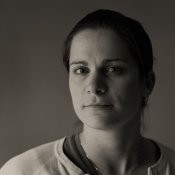Thomas Bertilsson
Member
Brian, I think you'll find that Ilford HP5 pushes quite nicely to 1600 in flat lighting.
You can also use a different developer to get a different result tonality wise. There are some developers that Edmund Lowe designed, Edwal 10 and Edwal 12, which changed the curve shape at normal speed. They understate the shadows, and give a stunning modulation of highlights right on the edge of breaking up.
Attached examples are Tri-X 400 and HP5+ developed in Edwal 12 (which is a fine grain version of Edwal 10). I'm not going to tell you which is which, because it does the same thing to both films, and in prints I can't really tell a difference. Both exposed in window light, both shot with the same 80mm Zeiss lens, at EI 400, and processed in Edwal 12. To me, TX400 and HP5+ are completely interchangeable.
Edwal 10 gives grain on par with ID-11 or D76, but has a different characteristic in giving deeper shadows (with less detail) and more intense highlights. Edwal 12 gives super fine grain, like replenished Xtol, but is otherwise pretty much the same as Edwal 10. These developers are great for flat lighting. They are not so good for extreme contrast.
- Thomas
You can also use a different developer to get a different result tonality wise. There are some developers that Edmund Lowe designed, Edwal 10 and Edwal 12, which changed the curve shape at normal speed. They understate the shadows, and give a stunning modulation of highlights right on the edge of breaking up.
Attached examples are Tri-X 400 and HP5+ developed in Edwal 12 (which is a fine grain version of Edwal 10). I'm not going to tell you which is which, because it does the same thing to both films, and in prints I can't really tell a difference. Both exposed in window light, both shot with the same 80mm Zeiss lens, at EI 400, and processed in Edwal 12. To me, TX400 and HP5+ are completely interchangeable.
Edwal 10 gives grain on par with ID-11 or D76, but has a different characteristic in giving deeper shadows (with less detail) and more intense highlights. Edwal 12 gives super fine grain, like replenished Xtol, but is otherwise pretty much the same as Edwal 10. These developers are great for flat lighting. They are not so good for extreme contrast.
- Thomas







 That was a match made in heaven. Now that Neopan is gone I've done a lot of work with ID-11 and find it a great developer. Xtol to me was a bit too fine grained. I like a little bit of bite. And ID-11 gives HP5 a nice bite. Both developers are great and can't go wrong either way.
That was a match made in heaven. Now that Neopan is gone I've done a lot of work with ID-11 and find it a great developer. Xtol to me was a bit too fine grained. I like a little bit of bite. And ID-11 gives HP5 a nice bite. Both developers are great and can't go wrong either way.